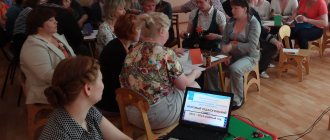MAGAZINE Preschooler.RF
“Travel games as an organization of joint activities between an adult and a child”In accordance with the Federal State Educational Standard in working with children of senior preschool age, one of the main principles is the principle of forming the child’s cognitive interests and cognitive actions, as well as the principle of supporting children’s initiative in various types of activities.
The priority of the Federal State Educational Standard for Preschool Education is gaming technologies, since gaming is the leading activity of preschool children.
The construction of an integrative pedagogical process involves the primary use of visual and practical methods and ways of organizing activities. Joint creative projects, holidays, observations, excursions, elementary experiments, travel games, game problem situations, role-playing games, etc., but I would like to dwell in more detail on travel games as an effective means of developing cognitive activity and initiative children in various types of activities in children of senior preschool age.
In older preschool age, intellectual interests are created on the basis of play interests. The ability to think independently, use acquired knowledge in mental operations is formed: find characteristic features, compare, group, classify objects, navigate in space, draw correct conclusions. All this will further contribute to successful learning at school. In this regard, the problem of developing the cognitive activity of preschool children, today, is becoming increasingly relevant. The goal of our work is to increase the level of cognitive activity of preschoolers through travel games.
Tasks:
- Development and activation of cognitive processes in children of senior preschool age;
- Formation of the ability to solve problem-search, game problems;
- Creating conditions for the development of independent cognitive activity. The practical significance and novelty of our work lies in the fact that the use of travel games in modern preschool educational institutions allows the teacher to effectively solve a number of issues related to the development of children’s cognitive activity and initiative in various types of activities, through the integration of educational areas.
The travel game is a sequential visit to various points on a previously prepared route. The children are given a task that has a playful nature (they go to Tsar Berendey, to the sweet tree). It is necessary to organize stops along the route where children will be offered various games and tasks.
Travel games are similar to a fairy tale, its development and miracles. They reflect real facts and events, but the ordinary is revealed through the unusual, the simple through the mysterious, the difficult through the interesting. All this happens in play, in play actions, it becomes close to the child and makes him happy.
A travel game is a game of action, thoughts, feelings of a child, a form of satisfying his needs for knowledge. The name of the game and the formulation of the game task should contain “calling words” that arouse children’s interest and active play activity. In a travel game, many ways of revealing cognitive content are used in combination with gaming activities: setting tasks, clarifying ways to solve them, sometimes developing travel routes, solving problems step by step, the joy of solving them, meaningful rest. The game sometimes includes songs, riddles, gifts and much more.
The purpose of the travel game is to enhance the impression, to make the educational content a little more fabulously unusual, to draw children’s attention to what is nearby, but is not noticed by them.
Thanks to travel games, children develop mental processes such as attention, memory, imagination, and perception more effectively. Children are given tasks such as overcoming difficulties and achieving success, which contributes to the development of logical thinking. Travel games arouse interest and active participation in the development of the game’s plot; children strive to master the rules of the game and get a result: solve a problem, find out something, learn something.
For example, in the game “Trip to the Zoo,” children gain knowledge about geometric shapes, repeat counting, and solve riddles.
In the game “Travel to Hometown,” children dance and listen to music; this includes tasks for attention, the ability to work in groups, and the ability to negotiate.
Thus, we can conclude that travel games for developing children’s initiative in various types of activities, for the formation of cognitive interests and cognitive actions of older preschoolers, are very effective.
| Next > |
Education of the younger generation
There is nothing more valuable in our life than the smile of a child. It is so important for parents that their children are healthy, able to study normally, and receive a quality education. For a baby, the mother is the main person to whom he trusts his problems and joys.
How to establish communication? It is important that parents are always nearby; it is useful to play board and outdoor games, involving the child in joint activities.
When a father builds a castle in the sand next to his son or a mother helps him with his homework, peace and tranquility always reign in the family.
It is thanks to the joint activities of the baby and parents that closer ties arise in the family. The child must understand that he is needed and important for his parents, that all his problems and successes worry both his father and mother.
It is important that parents become both teachers and interlocutors for their child.
Psychologists are absolutely sure that it is the joint activity of parents and children that helps the child develop as an individual.
It is necessary to prepare your child for entering first grade and lay the foundation for relationships with other people in early childhood. Children very subtly feel the love and care from their parents.
The child should feel constant attention, care, and support from relatives. In case of the slightest danger, the baby must be absolutely sure that they will hold him and help him cope with troubles.
It is important to love your child exactly as he really is. You should not make excessive demands on him that the baby will not be able to cope with. This will cause serious psychological trauma, which will negatively affect his entire future life. It is important to love your child exactly as he is, and not try to remake him to suit your requirements and desires.
Joint activities of teacher and children
Note 1
The joint activity of a teacher with children is one of the main models for organizing the educational process of preschool children. The activity of two or more participants in educational activities, that is, an adult and a student, aimed at solving educational problems in the same space and at the same time is characterized by the partner position of the adult and the partner organization of the child, that is, possible free placement, movement and communication in the process of educational activities.
The following forms of work with students are distinguished:
- individual;
- subgroup;
- frontal.
The following types of joint activities are also distinguished:
Are you an expert in this subject area? We invite you to become the author of the Directory Working Conditions
- directly educational activities, which are implemented in the joint activities of the teacher and children;
- joint activity of the teacher with children, which is carried out in the process of implementing routine moments and solves educational problems.
Types of joint activities:
- gaming;
- communicative;
- educational and research;
- productive.
The algorithm for the development of any type of activity is as follows: first, there is joint activity with teachers, and then joint activity with peers, and finally, the preschool child becomes an independent activity.
The characteristics of joint partnership between a teacher and children include:
- voluntary participation of children in activities, that is, there is no psychological and disciplinary coercion;
- open time periods - each child works at an individual pace;
- the possibility of free communication and movement of children;
- pedagogical support.
Taking into account the above-mentioned essential features of organizing joint activities, they should affect all routine moments carried out in the group, as well as all aspects of direct educational activities.
Finished works on a similar topic
Course work Joint and independent activities of teachers and children 410 ₽ Abstract Joint and independent activities of teachers and children 270 ₽ Test work Joint and independent activities of teachers and children 190 ₽
Receive completed work or specialist advice on your educational project Find out the cost
Achieving discipline within the framework of joint activities is possible only by using the informal authority of an adult, as well as by creating an integral system of interests, including the choice of topics of educational activity that are interesting and meaningful for the child.



